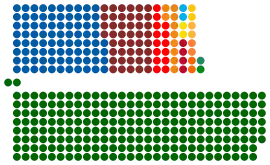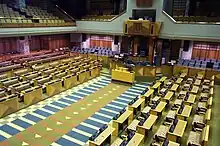Parliament of South Africa
The Parliament of the Republic of South Africa is South Africa's legislature; under the present Constitution of South Africa, the bicameral Parliament comprises a National Assembly and a National Council of Provinces.[2][3][4] The current twenty-seventh Parliament was first convened on 22 May 2019.
Parliament of the Republic of South Africa List
| |
|---|---|
| 27th Parliament | |
 | |
 | |
| Type | |
| Type | |
| Houses | National Assembly National Council of Provinces |
| Leadership | |
| Structure | |
| Seats | 490 90 National Council 400 National Assembly |
 | |
National Council of Provinces political groups | |
 | |
National Assembly political groups | Government (230)
Official Opposition (84)
Other parties (86) |
| Meeting place | |
.jpg.webp) | |
| Houses of Parliament, Cape Town Western Cape, South Africa | |
| Website | |
| www | |
| Zulu | iPhalamende yaseNingizimu Afrika |
|---|---|
| Xhosa | iPalamente yoMzantsi Afrika |
| Afrikaans | Parlement van Suid-Afrika |
| Sepedi | Palamente ya Afrika-Borwa |
| Swazi | iPhalamende yeNingizimu Afrika |
| Sesotho | Palamente ya Afrika Borwa |
| Setswana | Palamente ya Aforika Borwa |
| Xitsonga | Palamende ra Afrika Dzonga |
| Venda | Phaḽamennde ya Afurika Tshipembe |
| Southern Ndebele | iPalamende yeSewula Afrika |
.svg.png.webp) |
|---|
|
|
From 1910 to 1994, members of Parliament were elected chiefly by the South African white minority. The first elections with universal suffrage were held in 1994.
Both chambers held their meetings in the Houses of Parliament, Cape Town that were built 1875–1884. A fire broke out within the buildings in early January 2022, destroying the session room of the National Assembly. It was decided that the National Assembly would temporarily meet at the Good Hope Chamber.[5]
History
Before 1914
The predecessor of the Parliament of South Africa, before the 1910 Union of South Africa, was the bicameral Parliament of the Cape of Good Hope. This was composed of the House of Assembly (the lower house) and the Legislative Council (the upper house). It dated back to the beginnings of Cape independence in 1853 and was elected according to the multi-racial Cape Qualified Franchise system, whereby suffrage qualifications were applied equally to all males, regardless of race.
The buildings of the Cape Parliament went on to house the Parliament of South Africa, after union.[6][7]
1910–1994
When the Union of South Africa was established in 1910,[8] the Parliament was bicameral and consisted of the King or the Queen, the Senate, and the House of Assembly (known in Afrikaans as the Volksraad).
- The King (from 1952, the Queen of South Africa) was represented by the Governor-General.
- The Senate consisted of senators nominated by the four provinces, and by the Governor-General, initially for a period of ten years. The number of senators was changed from time to time. The Senate was chaired by a President of the Senate chosen by the senators from among themselves.
- The House of Assembly consisted of members who were directly elected by the voters. Each MP represented an electoral district (constituency), and most of them were elected on the basis of their political party. The number of constituencies and parliamentary seats was increased from time to time, in line with increases in the population. The House was chaired by a Speaker chosen by the MPs from among themselves.
- Only white men could be senators or MPs.
- The franchise (right to vote) was originally granted to white men in all four provinces, to black men in the Cape Province and Natal, and to Coloured men in the Cape Province – in all cases, the minimum age was 21 years.
The composition of Parliament was changed by constitutional amendments from time to time:
- From 1930, white women had the vote, and the right to serve as senators and MPs, on the same basis as white men.
- In 1934, Parliament was declared "the sovereign legislative power in and over the Union".[9]
- From 1937, black voters were separated from the other races – in the Senate they were represented by four elected senators (two for the Cape, one for Natal, one for the Orange Free State and Transvaal), and in the House of Assembly by three "native representative" MPs elected in separate black constituencies.[10]
- From 1950, white voters in South West Africa, which was under South African administration at that time, were represented by four senators and six MPs.
- From 1957, Coloured voters were separated from the whites – in the Senate, they were represented by separate senators, and in the House of Assembly by MPs elected in separate Coloured constituencies.[11] To pass this amendment in the face of strong opposition (and two Supreme Court rulings), prime minister Johannes Strijdom had to enlarge the Senate and appoint enough pro-government senators to get the two-thirds majority he needed to force through the constitutional change.[12]
- Representation of black voters was ended in 1960.
- Voting age was lowered from 21 to 18 in 1960.
In a referendum held in 1960, a small majority of the white voters approved the conversion of the country from a Realm or Dominion of the British Commonwealth to a republic.
1961–1984

The Republic of South Africa was established in 1961. The only change made to the composition of the Parliament was the substitution of the State President for the Queen.[14] A few significant changes were made later:
- Coloured representation was ended in 1968, leaving both the Senate and the House of Assembly representing white voters only.
- South West Africa ceased to be represented in Parliament from 1977.[15]
- The Senate was abolished in 1981, changing Parliament to a unicameral legislature.
1984–1994
A new Constitution, introduced in 1984, re-enfranchised the Coloured population (women as well as men) and enfranchised the Indian population. It retained the existing House of Assembly for whites and established a House of Representatives to represent the Coloureds, and a House of Delegates for the Indians, making Parliament a tricameral legislature. Blacks continued to be excluded.
- Each house consisted of members elected to represent constituencies, plus a few additional members elected by the MPs, and some nominated by the State President.
- Each house legislated on "own affairs" exclusive to its own race group, and they legislated jointly on "general affairs" affecting all races.[16] In practice, the House of Assembly, which had more MPs than the other two houses combined, continued to dominate the legislature.
- Each house was chaired by a chairman elected by its members from among themselves. They were coordinated by a Speaker of Parliament, elected by the members of all three houses in a joint sitting.
- The existing House of Assembly, elected in 1981, was deemed to have been re-elected in 1984, to coordinate its term of office with those of the two new houses. However, this was later overturned by the Supreme Court, and a separate election had to be held for the House of Assembly in 1987. The House elected in 1987 was then dissolved with the other houses in 1989.
The black majority were still disfranchised, and the new system lacked legitimacy even among the Coloureds and Asians, many of whom boycotted elections. In a referendum held in 1992, 68.73% of (only white) voters approved the reform process that effectively ended Apartheid. In late 1993, one of the last pieces of legislation passed by the tricameral Parliament was the Interim Constitution, which took effect on 27 April 1994, the same day as the first non-racial elections.
Since 1994
A new interim constitution, introduced in 1994 after four years of negotiation, finally introduced all-race democracy and enfranchised men and women of all races on equal terms, the minimum age remaining 18 years. Parliament was reconstituted to consist of a Senate and a National Assembly.
- The Senate consisted of 90 senators, ten nominated by each of the nine provinces. It was chaired by a President of the Senate elected by the senators from among themselves.
- The National Assembly consists of 400 members, elected by voters on a proportional representation/party list system. There are no electoral districts, and each party is allocated a number of seats proportionate to the percentage of the votes it receives across the country. It is chaired by a Speaker elected by the MPs from among themselves.
- In 1997, the current Constitution of South Africa came into force, in which the Senate was replaced by a 90-member National Council of Provinces (NCOP), made up of a 10-member delegation from each province (six delegates elected by the provincial legislature, the Premier and three other members of the provincial legislature). The NCOP is chaired by a Chairperson elected by the members from among themselves.
The parliamentary system uses proportional representation, with voters voting for political parties rather than for candidates.[17] Proportional representation allows for smaller parties to have a chance of acquiring seats in parliament, although these parties often combine in order to have a stronger voice within the political system, especially against the ANC. The Independent Electoral Commission is charged with keeping elections fair, regular, and equal. Parties submit closed lists of candidates to the IEC, and the IEC fills the seats allotted to individual parties using the candidate lists after election results come in. The electoral system has seen little corruption since 1994.
International Relations Minister and Cooperation Naledi Pandor has noted that during her term (starting 1994) a decline in political respectability had occurred in parliament, due to its members not engaging with one another in a courteous manner. She remarked that she felt undignified to be an observer of the crude behaviour, which also inhibited the conduct of successful politics.[18]
Major political parties in parliament
African National Congress: The ANC was founded in 1912, but were banned by State President Charles Robberts Swart in 1960, remaining so until the ban was lifted thirty years later by President F. W. De Klerk. The ANC became the leading political party in South Africa after the first multi-racial election in 1994. The party's main platform rests on working towards racial equality and eradicating the socio-economic classes which are often based on race. The ANC has been considered a party for native South Africans, especially before 2009 when party leader Jacob Zuma faced multiple accusations regarding corruption, particularly using public funds for his own purposes.[22] The economic difficulties in South Africa, as well as police brutality have both been blamed on the ANC. Currently, the ANC holds 230 seats in parliament. Support for the ANC went down between the 2014 and the 2019 general elections, with violent protests erupting all over the country in response to the allegations of corruption within the ANC and the non-delivery of municipal services.
Democratic Alliance: The DA was formed when the New National Party, the successor to the apartheid-era National Party, merged with the Democratic Party and the Federal Alliance in 2000 to form an alliance. The DA is an opposition party and has been traditionally supported by South Africa's minority communities (White, Coloured and Indian). In more recent years, the party has attempted to win votes from Black South Africans and as a result, Black support for the DA has risen over the past several years, going from 1% to 6%.[23] The DA is a liberal party that favours free-market policies. The DA was allotted 89 seats in parliament after the 2014 general election, but the party's seat total decreased to 84 seats following the 2019 general election.
Economic Freedom Fighters: The EFF emerged eight months before the 2014 general election and won 25 seats in parliament. After the 2019 general elections, the EFF increased their seats in parliament to 44, the only party of the top three parties that achieved an increase of members in parliament. The EFF is a far-left revolutionary socialist political party, advocating for land expropriation and for an end to corruption within parliament.[24]
Inkatha Freedom Party: The IFP, which was formed in 1990 was the successor to the former government in the now-defunct Kwazulu Bantustan, traditionally draws its support from the Zulu people. It has however made inroads into the minority electorate of Whites and Indians. The IFP was the third-largest party until it was unseated by the EFF and is one of the few parties to have consecutive representation in parliament since democracy in 1994. The IFP apart from the ANC was part of the National Government for 10 years. The IFP champions the rights of traditional leaders and advocates for policies which favour free markets. The party is opposed to socialism and communist policies.
Because the ANC has such a large majority in parliament, smaller parties are constantly forming alliances and coalitions in order to act as a stronger opposition to the ANC-run legislative and executive branches.
Seat of Parliament
Parliament sits at the Houses of Parliament, Cape Town, even though the seat of government is in Pretoria. This dates back to the foundation of the Union, when there was disagreement among the four provinces as to which city would be the national capital. As a compromise, Cape Town was designated the legislative capital, Bloemfontein the judicial capital, and Pretoria the administrative capital. The African National Congress (ANC) government has proposed moving Parliament to Pretoria, arguing that the present arrangement is cumbersome as ministers, civil servants and diplomats must move back and forth when Parliament is in session.
However, many Capetonians have spoken out against such a move, accusing the ANC of trying to centralise power. Under the Constitution, there is provision for Parliament to sit elsewhere than Cape Town on grounds of public interest, security or convenience and Parliament is permitted to provide in its rules and orders for sittings outside Cape Town. Rule 24 of the National Assembly Rules accordingly allows the Speaker to direct that the House will sit at 'a place other than the Houses of Parliament in Cape Town' after consulting the Leader of the House and the Chief Whip of each party represented in the House. Rule 23 of the rules of the National Council of Provinces allows the council to pass a resolution providing for it to sit elsewhere.
In 2018, the Government of South Africa formed a project steering committee to conduct a feasibility study into moving parliament to Pretoria and to identify potential sites for a new parliament building.[25] In April 2019, the Minister of Public Works announced that a list of potential sites had been drawn up.[26] In 2020, it was suggested that moving parliament to Pretoria would save R650 million per year.[27]
In January 2022, a fire broke out at the Houses of Pariament building in Cape Town causing severe damage to the session rooms of both the National Council of Provinces and the National Assembly. The 2022 State of the Nation Address was held at Cape Town City Hall and subsequent meetings of the National Assembly will be held at Good Hope Chamber. The temporary debating chamber has previously been used for committee meetings of the National Assembly and has a seating capacity of 170, reduced to 70 during COVID-19 precautions.[28] The National Assembly has 400 members.
List of Parliaments
Parliaments of the Union
- 1st South African Parliament (1910–1915) – majority party : South African Party
- 2nd South African Parliament (1915–1920) – majority party : South African Party
- 3rd South African Parliament (1920–1921) – majority party : South African Party
- 4th South African Parliament (1921–1924) – majority party : South African Party
- 5th South African Parliament (1924–1929) – majority party : National Party
- 6th South African Parliament (1929–1933) – majority party : National Party
- 7th South African Parliament (1933–1938) – majority party : United Party
- 8th South African Parliament (1938–1943) – majority party : United Party
- 9th South African Parliament (1943–1948) – majority party : United Party
- 10th South African Parliament (1948–1953) – majority party : National Party
- 11th South African Parliament (1953–1958) – majority party : National Party
- 12th South African Parliament (1958–1961) – majority party : National Party
Parliaments of the Republic
- 13th South African Parliament (1961–1966) – majority party : National Party
- 14th South African Parliament (1966–1970) – majority party : National Party
- 15th South African Parliament (1970–1974) – majority party : National Party
- 16th South African Parliament (1974–1977) – majority party : National Party
- 17th South African Parliament (1977–1981) – majority party : National Party
- 18th South African Parliament (1981–1984) – majority party : National Party
- 19th South African Parliament (1984–1987) – majority party : National Party
- 20th South African Parliament (1987–1989) – majority party : National Party
- 21st South African Parliament (1989–1994) – majority party : National Party
Democratic Parliaments
- 22nd South African Parliament (1994–1999) – majority party : African National Congress
- 23rd South African Parliament (1999–2004) – majority party : African National Congress
- 24th South African Parliament (2004–2009) – majority party : African National Congress
- 25th South African Parliament (2009–2014) – majority party : African National Congress
- 26th South African Parliament (2014–2019) - majority party : African National Congress
- 27th South African Parliament (2019–present) - majority party: African National Congress
See also
References
- Fisher, Shamiela. "Good will remain opposition party, despite De Lille appointment as minister". ewn.co.za. Retrieved 5 June 2019.
- Constitution of the Republic of South Africa, 1996, s. 42 Archived 13 April 2014 at the Wayback Machine
- Odeyemi, Temitayo Isaac; Abioro, Tunde (4 August 2018), "Digital Technologies, Online Engagement and Parliament-Citizen Relations in Nigeria and South Africa", Advances in African Economic, Social and Political Development, Springer International Publishing, pp. 217–232, doi:10.1007/978-3-319-93509-6_12, ISBN 9783319935089, S2CID 158523324
- Odeyemi, Temitayo Isaac; Olorunshola, Damilola Temitope; Ajibola, Boluwatife Solomon (9 April 2023). "Turning public engagement into standard practice : institutionalisation in the work of the South African Parliament". The Journal of Legislative Studies: 1–19. doi:10.1080/13572334.2023.2195147. ISSN 1357-2334. S2CID 258076520.
- "LOOK: Check out the National Assembly's 'new' venue [PICS]". The South African. 14 January 2022. Retrieved 14 January 2022.
- The old Cape House, being pages from the history of a legislative assembly, Ralph Kilpin, T.M Miller, Cape Town, 1918
- The Houses of Parliament, Cape Town, Andrew Cusack, 3 November 2009
- South Africa Act 1909
- Status of the Union Act 1934
- Representation of Natives Act 1936
- Separate Representation of Voters Act 1956
- Senate Act 1955
- "Republic of South Africa", Hubert de Vries.
- Republic of South Africa Constitution Act 1961
- SOUTH AFRICA Date of Elections: 30 November 1977, Inter-Parliamentary-Union
- Republic of South Africa Constitution Act 1983
- Odeyemi, Temitayo Isaac; Olorunshola, Damilola Temitope; Ajibola, Boluwatife Solomon (9 April 2023). "Turning public engagement into standard practice : institutionalisation in the work of the South African Parliament". The Journal of Legislative Studies: 1–19. doi:10.1080/13572334.2023.2195147. ISSN 1357-2334. S2CID 258076520.
- du Plessis, Carien (10 December 2018). "Naledi Pandor: 'Work has to go on, the nation has to continue to exist'". Daily Maverick. South Africa. Retrieved 11 December 2018.
- Merten, Marianne (2 January 2022). "OUR BURNING ASSEMBLY: Major fire wracks parliament building, raising questions about why no protection services staff were on duty". Daily Maverick. Retrieved 2 January 2022.
- Charles, Marvin (2 January 2022). "Man, 49, arrested in connection with Parliament fire". News24.
- "South African police charge man with arson over damaging blaze at parliament". Reuters. 3 January 2022. Retrieved 3 January 2022.
- "Can we blame you now, President Zuma? | Corruption Watch". Corruption Watch. 7 April 2015. Retrieved 6 May 2016.
- Sapa, TimesLIVE. "South Africa election results 2014". Times LIVE. Retrieved 6 May 2016.
- "2019 vs 2014: What the numbers tell us about the general elections". News24. Retrieved 12 May 2019.
- Staff Writer. "Government identifies possible sites to move parliament from Cape Town to Pretoria". Retrieved 30 May 2021.
- Diemen, Ethan van. "Sites identified for potential Parliament move to Tshwane". News24. Retrieved 30 May 2021.
- Boje, Valerie. "Moving Parliament to Pretoria may save the government R650m a year: professor". Independent Online. South Africa. Retrieved 30 May 2021.
- "LOOK: Check out the National Assembly's 'new' venue [PICS]". The South African. 14 January 2022. Retrieved 14 January 2022.
- South Africa Act 1909
- Constitution of the Republic of South Africa 1961
- Constitution of the Republic of South Africa 1983
- Constitution of the Republic of South Africa 1993
- Constitution of the Republic of South Africa 1996
- Kahn, E. (1961). The New Constitution.
- Kruger, D.W. (1969). The Making of a Nation.
- May, H.J. (1949). The South African Constitution.
External links
![]() Media related to Parliament of South Africa at Wikimedia Commons
Media related to Parliament of South Africa at Wikimedia Commons
